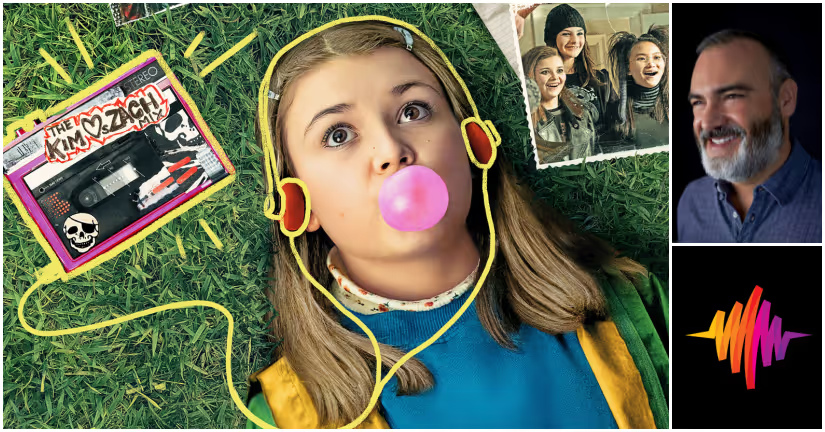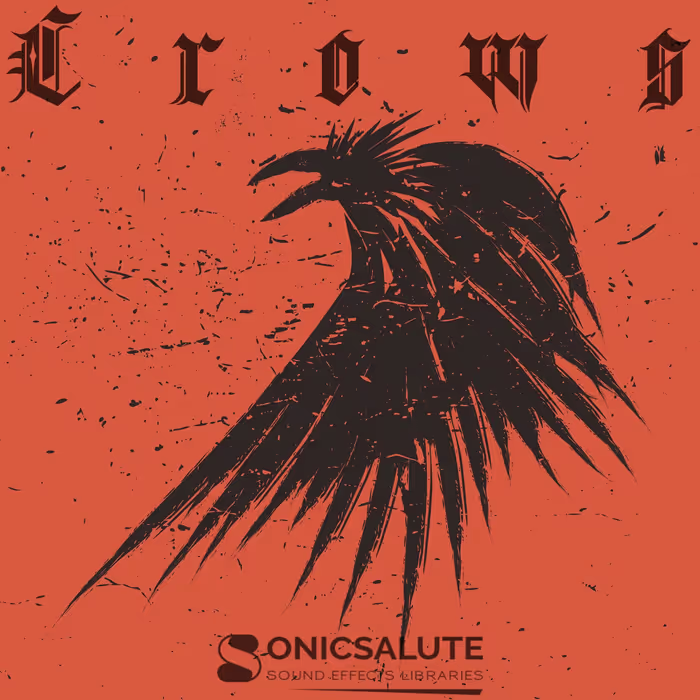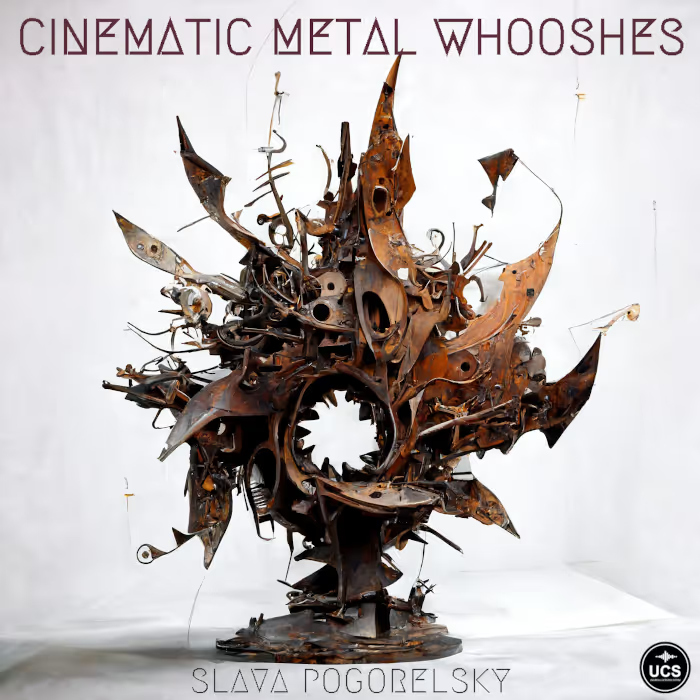There is much to love about the music of the ’90s – bands like Radiohead, Rancid, Blink-182, Bjork, Nirvana, The Bouncing Souls, PJ Harvey, Portishead, Nine Inch Nails, Dropkick Murphys, Sunny Day Real Estate, Sublime, Tori Amos, G. Love & Special Sauce… all those songs and sounds of my formative years. Making mixtapes was my generation’s way of sharing feelings, of capturing memories and crystalizing them on a cassette tape for eternity (or at least until the tape melted on your dashboard). It wasn’t a ‘playlist’ like today, where you can randomize the song order. A mixtape is a carefully curated selection of songs laid out in a meaningful order. It’s an analog artform that drowned in the rising flood of digital media.
The magic of the mixtape is revived in Netflix’s aptly named filmed Mixtape – a charming tale of a young orphan girl named Beverly who finds her mom’s mixtape in a box in the basement, but before Beverly can play it through the tape is destroyed in her walkman. Beverly sets out on a quest to track down each song on the tape, to learn about who her parents were, and to find out who she is along the way. It’s a heartwarming film with a cool punk-driven soundtrack.
Here, Formosa Group‘s Emmy and MPSE Award-winning supervising sound editor Odin Benitez and I chat about the lasting impact of the 90s, musical influence and evolution, the challenges for him and his sound team on Mixtape, mixing remotely, and more!
Mixtape | Official Trailer | Netflix
Mixtape is such a fun, heart-warming film. I loved the ’90s Alt-Rock tracks and punk tracks…

Odin Benitez (OB): It’s interesting that these ‘retro’ films are during a time when I was already a professional. It makes you feel old.
But it’s cool. Valerie wanted to make sure that the period of the film was established. At every opportune time, we would have a radio announcer mention Y2K and that whole worry, or relevant commercials from that period, and music that reflected the time.
When you look at the cars and clothes in the film, there isn’t a striking difference between then and now. Today, you still see people driving around in cars from the ’90s, and wearing jeans and tee-shirts. The 90s are still alive and present…
OB: I heard a statistic that Nirvana is actually the halfway point between now and the beginning of Rock ‘n’ Roll.
That’s hard to believe that there had been so much innovation from the ’50s to the ’60s to the ’70s and up to the ’90s, but then after that, the innovation doesn’t seem to be there anymore, or maybe not as noticeable. It’s just a different beast, I guess.

Yeah, an Alt-Rock band today sounds very similar to one from the Nirvana era. There’s not much radical difference. You have synths, guitars, and distortion…
OB: Yeah, take Bruno Mars, for example. He’s basically harkening back to Prince and the Minneapolis sound at times, which was a total innovation in its time.
It’s interesting. I wonder if it’s because of the decentralized nature of the music industry, how people are basically going through and finding their own likes and dislikes, finding their own audiences. It’s not so directed by one music industry. Although, that’s still going on with certain artists.
Do you know that song “Brutal” by Olivia Rodrigo? Well, that’s basically “Pump It Up” from Elvis Costello. I played that song for my girlfriend’s daughters who really like her music and they were surprised. But then again, Elvis got it from Bob Dylan’s “Subterranean Homesick Blues” and he got it from Chuck Berry’s “Too Much Monkey Business.” So, the influences all carry forward.

It’s influence but interpretation, too. The artist puts their unique spin on it…
OB: That’s how most musical artists work. They are influenced by other artists around them. I think that Paul McCartney said The Beatles were plagiarists extraordinaire. And my son Sean, too, writes songs and he’ll get inspired by an artist – whether it’s Harry Styles or Arctic Monkeys or whoever – and then he starts writing.
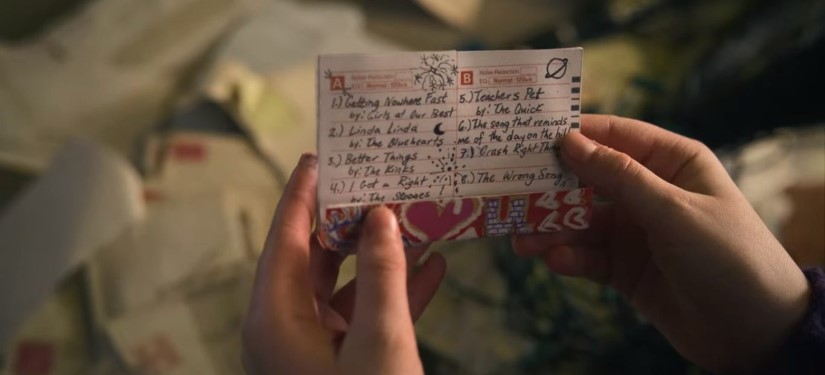
It’s interesting, too, to hear the progression of a band that has a long career because their influences change over the years, and they have an evolution as a band within this wider context of music evolving as a whole. Look at Radiohead, from Pablo Honey to A Moon Shaped Pool there’s such a change…
OB: OK Computer is an amazing album.
Radiohead is interesting, too. Their song “Creep” is basically the Hollies’ “The Air That I Breathe.”
I think Brian Eno said the guitar in every artist’s hand becomes kind of a unique instrument. There are things that Jimi Hendrix can do that I don’t think anyone can duplicate. Keith Richards, too. There’s just this sound that they have and it’s unique.

Music obviously plays a huge role in Mixtape. In what other ways did director Valerie Weiss want to use sound to help tell this story?
OB: We touched on it a bit earlier but I’d say that Valerie wanted to feel as if you’re in the ’90s era, and also in that location of Spokane, Washington. She wanted to be true to the era and the area.
She wanted to be true to the era and the area.
We had lots of commercials on the radio and in the record store. She wanted to make sure we had a lot of music from the era that went into this sonic production design. That was a big area.
One of the biggest challenges for sound in the film was in the forest, where the kids go to that haunted forest. They wanted to create this spooky, ghost-like ambience but when you watch the film, there isn’t anything visually spooky about it. So our job was to figure out how to get the sound they want that worked with the visuals they have, without it coming across as corny or unrealistic.
We went through a lot of iterations. Russell Topal was my sound effect editor/sound designer. He did a great job on the film.
…we ended up working with subtle winds and we also did movement in the forest, like branches falling or snapping and wood creaks.
Sometimes we had a lot of birds and animals in the forest, but they asked us to pull back on that. Valerie at one point suggested a woodpecker, which I thought was a great idea. But then they decided to not use that.
Instead, we ended up working with subtle winds and we also did movement in the forest, like branches falling or snapping and wood creaks. We were trying to make the forest come alive with those sound effects. That seemed to be effective enough, along with the subtle winds. We also brought in some birds and animals to punctuate certain moments.
But that was definitely one location that we kept going back to and kept evolving until we got it to its final form.
…she’ll have a boombox playing music that should inspire the scene.
One interesting thing that Valerie does when she shoots is that in certain scenes she’ll have a boombox playing music that should inspire the scene. Obviously, that’s going to create an issue with dialogue and in some cases, we needed to completely loop scenes or sections where the music bleed was too extensive and we couldn’t get rid of it.
For instance, there was one scene where they were singing that song “Teacher’s Pet” – it was part of that sequence where they were creating the school mascot buttons. It cuts between that to scenes in the garage where the girls are playing along to the song. In that case, they had tons of music bleed and I think only one boom microphone was working. So Harrison Meyle (dialogue/ADR supervisor) had to loop all that and the kids had to redo the vocals of that song on the ADR stage.
We were going to reproduce their instruments too – the drums and the guitars.
We were going to reproduce their instruments too – the drums and the guitars. We were going to do it in a garage-style format. But, in the end, it’s the original stem of the music from the song with the kids’ ADR singing. That’s what made it into the final movie.
There were several instances like that, where we needed to completely loop them. The end song was also one of those moments as well.
Another challenge was that we had to come up with some interesting button-making sounds that cut through that song. The foley team really came through for that. And we heightened it with some sound effects.
The filmmakers also wanted to make sure the fireworks felt right…
The filmmakers also wanted to make sure the fireworks felt right, that they weren’t too big at the beginning because they wanted them to build at the end. So we needed to find a careful balance that would mix with the song but wouldn’t be too strong at first. The fireworks we had initially were way too big for them, but we found a good middle ground for the final, and I think it works well.
In terms of the overall soundtrack, some of the filmmakers wanted to go more minimalistic and others wanted the space filled with environmental sounds and off-stage mini-dramas. So, we went back and forth with adding off-screen car-bys and then taking them out, adding in birds and then taking them out. There were some conflicts among the filmmakers as to how much of the world we should hear. I remember us adding in more and more sound even though there was already a ton of stuff there because it was something that kept coming up.
I think sometimes when we add too many off-screen sound effects on certain films, it’s because the director isn’t confident that the scene looks real.
I think sometimes when we add too many off-screen sound effects on certain films, it’s because the director isn’t confident that the scene looks real. They’re worried that it looks like a set because they know it’s a set. Not to say that’s what was happening with this film, but it’s usually a tell-tale sign when they want to have a lot of sound happening off-screen that they’re not confident in their location.
In the end, the filmmakers on Mixtape were very confident in the drama and the scenes they were portraying. I think it was the right decision to just let the scene play and to not have distracting car-bys and too many off-screen birds.
In some of the scenes, like the record shop, we did use off-screen sound to make it feel like there was a lot of town life happening around them. Sometimes we played that up and other times we let the drama take the scene. But when you look out the window of the record shop, you don’t see a lot happening. So our challenge was figuring out how to make it sound like there was a vibrant town outside without making it feel out of place with the visuals.
Another location that Valerie wanted to focus on was the club. She really wanted that to feel real.
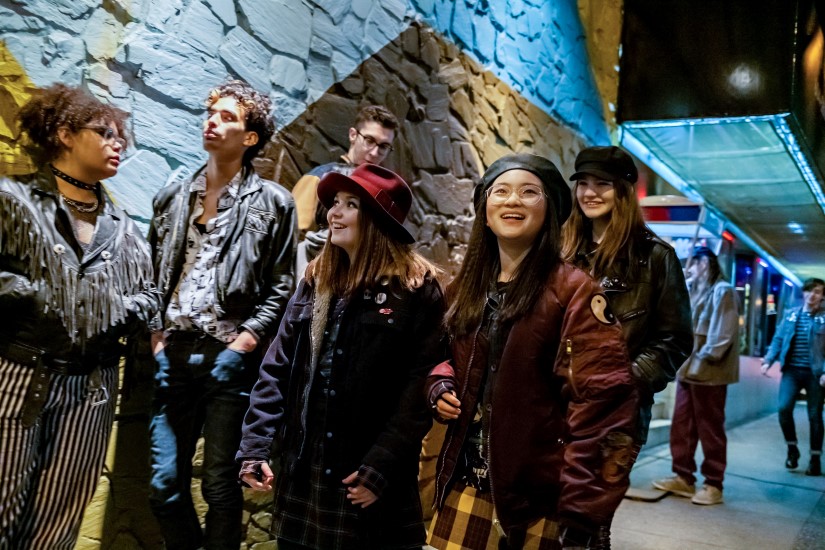
Looking at that club scene – where the girls and their record shop ‘friend’ go to see the Wes Kelly Band – how did you handle the music and sound of that scene?
OB: That was hard for me because I don’t have many great tracks for nightclubs. It’s hard to record one, too, because they’re usually playing music at the club. And the club in the film wasn’t a giant auditorium full of people. It’s more like a bar, which also typically has music.
Loop group played a huge role in helping to bring out the detail.
Another factor is that the club had two different areas: close to the stage and the bar area. The filmmakers wanted to hear the difference between those two. I was able to find a few tracks that helped with the body movement of the people near the stage (like dance footsteps) to help you feel the presence of the people there, and for the bar, we had clinks and bartender routines.
Loop group played a huge role in helping to bring out the detail.
I once did a low-budget film where they didn’t book any loop group and we thought we could cover it with effects. But once we got on the stage, we realized how much we needed group. There are different layers that work together to create a crowd sound. You have an ambience bed walla to fill the space, the loop group that helps to lift it off the screen, and then the principle dialogue. Missing that group layer is quite noticeable. The group layer for the club scene also helped to add responses from the audience.
During the mix, our re-recording mixers Andy D’Addario and Emilie Corpuz did such a phenomenal job recreating that feel that you’re in a nightclub. That was one of the biggest challenges they had because they were doing most of the film previews via Zoom or PIX, and they were recording the audience’s responses as well so that brought the overall bandwidth of the show’s audio really low. So as they were previewing the film, the audience was hearing awful audio quality. There was really nothing we could do no matter how good we got the tracks to sound. Once it was put through that pipeline it wasn’t going to sound good. I’ll be glad when we can have screenings in real theaters again!
So as they were previewing the film, the audience was hearing awful audio quality. There was really nothing we could do no matter how good we got the tracks to sound.
So once we got to the dub stage, they were very keen on making it sound nice and full, and we achieved that. The filmmakers were very happy. And of course, it sounds great on Netflix.
As for the music, the Wes Kelly Band wasn’t doing anything live. It was all playback. That was one of the big mix challenges for Andy [D’Addario], to make that sound like you’re in a club. There were different perspectives, too. Sometimes the camera was close-up on the singer and sometimes you’re in the crowd in front of the stage and then you’re further back in the bar. Andy had to work really hard to make that work.
The second song they played at the club, the more ballad-type song, already had a really nice treatment on it so it wasn’t quite as challenging.
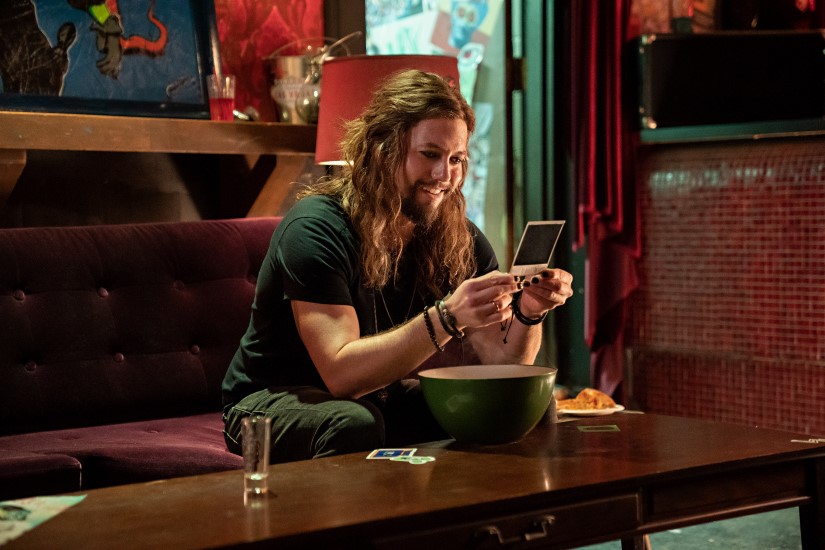
For the girls’ concert at the end, I’m sure that was all playback. I don’t think it would be possible for the kids to get that good at playing instruments that quickly…
OB: Yeah, that’s one of those conceits, right? Any musician knows that they’d have to struggle hard even to just play a chord let alone a whole number. When Anti, the record shop guy, goes up to play it’s more believable because he was supposedly in a band.
But I do think the actress who played Beverly (Gemma Brooke Allen) was singing the vocals.
[tweet_box]Making the Nostalgic ’90s Sound of Netflix’s Mixtape – with Odin Benitez[/tweet_box]

What would you want other sound pros to know about your work on Mixtape?
OB: The biggest thing about this film – and it’s the first time I ever had this challenge – was that I couldn’t be on the stage for the mix. I had gotten back from Mexico and due to Covid protocols, I wasn’t allowed back on the stage. Todd Toon was an additional supervising sound editor on the film and was on the stage when I couldn’t be there. So I had to monitor the mix via ClearView. Also, I think Harrison had to do the same thing because we couldn’t have too many people on the stage.
I was surprised at how well I was able to hear what was happening with the mix…
The ClearView approach worked great. We were able to handle any effects requests quickly by uploading the edited files they needed. I was able to listen to the dub as well. It was a stereo feed but when you think about this film being a Netflix release, you know the audience is going to be listening back in a near-field environment. I was surprised at how well I was able to hear what was happening with the mix, and I was able to ask the mixers to raise this or lower that. It was a surprisingly effective way of dealing with that situation where you can’t be on stage.
Almost every other film I’ve worked on during the pandemic, I’ve been on the dubbing stage. This film was the exception, but it did work out.

Attending the mix remotely and getting to experience that as how a producer or even director might experience it, did that give you confidence in this remote mixing process?
OB: Yeah, I think so. I do have a set of really good headphones though. Oftentimes, I don’t know what the producers are monitoring through. Are they listening through their Mac speakers? I’ve stressed to post supervisors that it would be great if we all had the same headphones so that we had a common ground for playback. This way we’re giving notes on the same playback of the mix. I’ve done films where the filmmakers say that the sub sounds tinny. And I ask, “What are you listening through? It sounds huge to me.” Then when they hear it on a stage, they’re like, “Oh, yeah, that sounds huge.”
So, it does work but I hope we don’t have to do it much longer.
If everyone is monitoring on the same headphones, then at least we have a common ground and we can give notes properly.
So, it does work. You’re not hearing things in Atmos or 7.1, so there’s a drawback there. But at least you’re getting specific details like the lines of dialogue, and key sound effects, and you can hear if the music is playing correctly.
I had done a mix where the Apple executives were listening on their Apple headphones and they’d have good notes – like, the music was too loud here or we could be more adventurous there. So, it does work but I hope we don’t have to do it much longer.
A big thanks to Odin Benitez for giving us a behind-the-scenes look at the sound of Mixtape and to Jennifer Walden for the interview!

